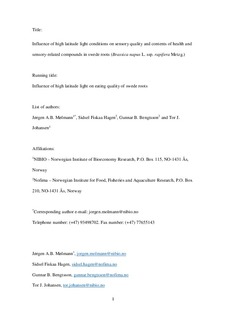| dc.contributor.author | Mølmann, Jørgen | |
| dc.contributor.author | Hagen, Sidsel Fiskaa | |
| dc.contributor.author | Bengtsson, Gunnar | |
| dc.contributor.author | Johansen, Tor Jacob | |
| dc.date.accessioned | 2018-04-17T11:00:58Z | |
| dc.date.available | 2018-04-17T11:00:58Z | |
| dc.date.created | 2017-09-08T13:39:37Z | |
| dc.date.issued | 2017 | |
| dc.identifier.citation | Journal of the Science of Food and Agriculture. 2017, 98 (3), 1117-1123. | nb_NO |
| dc.identifier.issn | 0022-5142 | |
| dc.identifier.uri | http://hdl.handle.net/11250/2494451 | |
| dc.description.abstract | BACKGROUND Vegetable growers in Arctic areas must increasingly rely on market strategies based on regional origin and product quality. Swede roots (rutabaga) were grown in a phytotron to investigate the effect of high latitude light conditions on sensory quality and some health and sensory-related compounds. Experimental treatments included modifications of 24 h natural day length (69° 39' N) by moving plants at daily intervals to dark chambers with either no light, fluorescent growth light and/or low intensity photoperiod extension. RESULTS Shortening the photosynthetic light period to 12 h produced smaller roots than 15.7 h and 18 h, with highest scores for bitter and sulfur taste, and lowest scores for sweetness, acidic taste and fibrousness. The photoperiod in combination with the photosynthetic light period also had an influence on glucosinolate (GLS) contents, with lowest concentrations in 24 h natural light and highest in 12 h natural light. Concentrations of vitamin C, glucose, fructose and sucrose were not significantly influenced by any of the treatments. CONCLUSION High latitude light conditions, with long photosynthetic light periods and 24 h photoperiod, can enhance sweet/less bitter taste and reduce GLS contents in swede roots, compared to growth under short day conditions. This influence of light conditions on eating quality may benefit marketing of regional products from high latitudes. © 2017 Society of Chemical Industry | |
| dc.language.iso | eng | nb_NO |
| dc.title | Influence of high latitude light conditions on sensory quality and contents of health and sensory-related compounds in swede roots (Brassica napus L. ssp. rapifera Metzg.) | nb_NO |
| dc.type | Journal article | nb_NO |
| dc.type | Peer reviewed | nb_NO |
| dc.description.version | submittedVersion | |
| dc.source.pagenumber | 1117-1123 | nb_NO |
| dc.source.volume | 98 | nb_NO |
| dc.source.journal | Journal of the Science of Food and Agriculture | nb_NO |
| dc.source.issue | 3 | nb_NO |
| dc.identifier.doi | 10.1002/jsfa.8562 | |
| dc.identifier.cristin | 1492140 | |
| dc.relation.project | Norges forskningsråd: 195306 | nb_NO |
| dc.relation.project | Nofima AS: 4101 | nb_NO |
| dc.relation.project | Norges forskningsråd: 262300 | nb_NO |
| dc.relation.project | Nofima AS: 201303 | nb_NO |
| dc.relation.project | Norges forskningsråd: 224892 | nb_NO |
| dc.relation.project | Nofima AS: 201701 | nb_NO |
| cristin.unitcode | 7543,3,1,0 | |
| cristin.unitname | Mat og helse | |
| cristin.ispublished | true | |
| cristin.fulltext | preprint | |
| cristin.qualitycode | 1 | |
